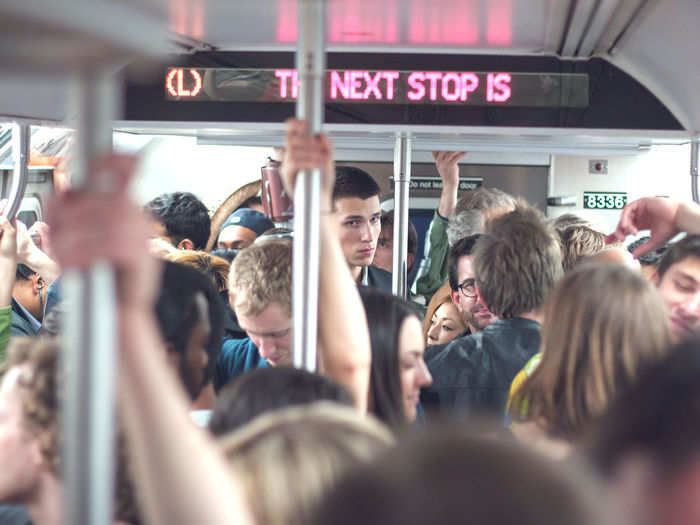
Many New Yorkers feared that an influx of 25,000 Amazon employees would place additional strain on the city's already crowded subway system. Commuters complain that the 7 subway line, the most direct route from Long Island City to midtown Manhattan, is extremely congested during peak hours — and roads on the Queensboro Bridge aren't much better.
New York City is the third most traffic-congested city in the world and the second most traffic-jammed city in the US.
In November, Ocasio-Cortez said the city shouldn't be handing Amazon tax breaks "at a time when our subway is crumbling."

Just as Amazon has been criticized for the skyrocketing rents in Seattle, some New Yorkers feared that that their neighborhoods could suddenly become more expensive.
A fifth of households in Queens live in poverty. Yet in Long Island City, rents have already risen by more than 5% from year to year. With apartments in Long Island City almost fully occupied, prices were likely to rise further given the presence of HQ2. The company's proposed development would also have squashed plans to build affordable units along the waterfront.
Rents in Hunters Point, the neighborhood where many Amazon employees were likely to live, hover at $2,700 per month — nearly double the national average. The median cost of home in Hunters Point is even higher: around $1.2 million, or more than five times the national average.

Amazon estimated that the average salary of its 25,000 HQ2 employees in New York would be $150,000 — well above the median income of local residents.
About 12,500 of those positions were expected to be in administration, custodial, and other non-tech roles. The remaining 12,500 would most likely have required a bachelor's degree or coding background. Some New Yorkers feared that Amazon would bring in its tech talent from other states.
Research from Timothy Bartik, an economist at the W. E. Upjohn Institute, shows that companies accepting incentives packages from a city tend to hire local in the short team, but after a few decades, around 85% of their jobs go to outside residents.

As part of the Amazon deal, New York gave the company up to $1.7 billion in economic incentives. Many residents and politicians worried that this subsidy would come at the expense of local taxpayers.
explained what happens when a company like Amazon doesn't pay their taxes.
"There will be a huge burden shift," the director of Good Jobs First, Greg LeRoy, wrote in an editorial for Fast Company. "Either everyone else's taxes will have to go up, or the quality of public services will have to go down, or some of both. There's no such thing as free growth."

In November, a Zillow senior economist predicted that Amazon's HQ2 would introduce 830 new homeless residents to New York City.
That number may seem small in relation to the city's current total of 77,000 homeless residents. But the threat of increased homelessness may have felt particularly ominous for Long Island City, since the community that attracts a growing share of the city's homeless population.
A flyer circulated by Senator Gianaris earlier this month pointed to street homelessness in Seattle as an example of the future awaiting Long Island City.

Gianaris' flyer also noted that Amazon's Web Services was helping ICE track immigrants.
The claim is based on a 2018 investigation from the National Immigration Project, Immigrant Defense Project, and activist organization Mijente. The groups found that Amazon provided ICE with management software that allowed it to separate migrant children from their parents.
At a December New York City Council meeting to discuss Amazon HQ2, council members questioned the tech giant about its government contracts. Signs outside the meeting read "Amazon causes family separation."

Jeff Bezos may be donating his own dollars to early education, but some Long Island City residents worried that Amazon wouldn't do enough for schools in their neighborhoods. In its deal with New York, the company only set aside funds for one middle school in the area, which was set to be built on land that HQ2 planned to take over.
Many residents were particularly concerned about overcrowding in schools due to an onslaught of Amazon employees (and their kids). High schools in Queens have already exceeded capacity, as has the only elementary school in Long Island City. The situation has caused some younger students to be wait-listed at schools, and others to be taught in trailers.
 In second consecutive week of decline, forex kitty drops $2.28 bn to $640.33 bn
In second consecutive week of decline, forex kitty drops $2.28 bn to $640.33 bn
 SBI Life Q4 profit rises 4% to ₹811 crore
SBI Life Q4 profit rises 4% to ₹811 crore
 IMD predicts severe heatwave conditions over East, South Peninsular India for next five days
IMD predicts severe heatwave conditions over East, South Peninsular India for next five days

Copyright © 2024. Times Internet Limited. All rights reserved.For reprint rights. Times Syndication Service.